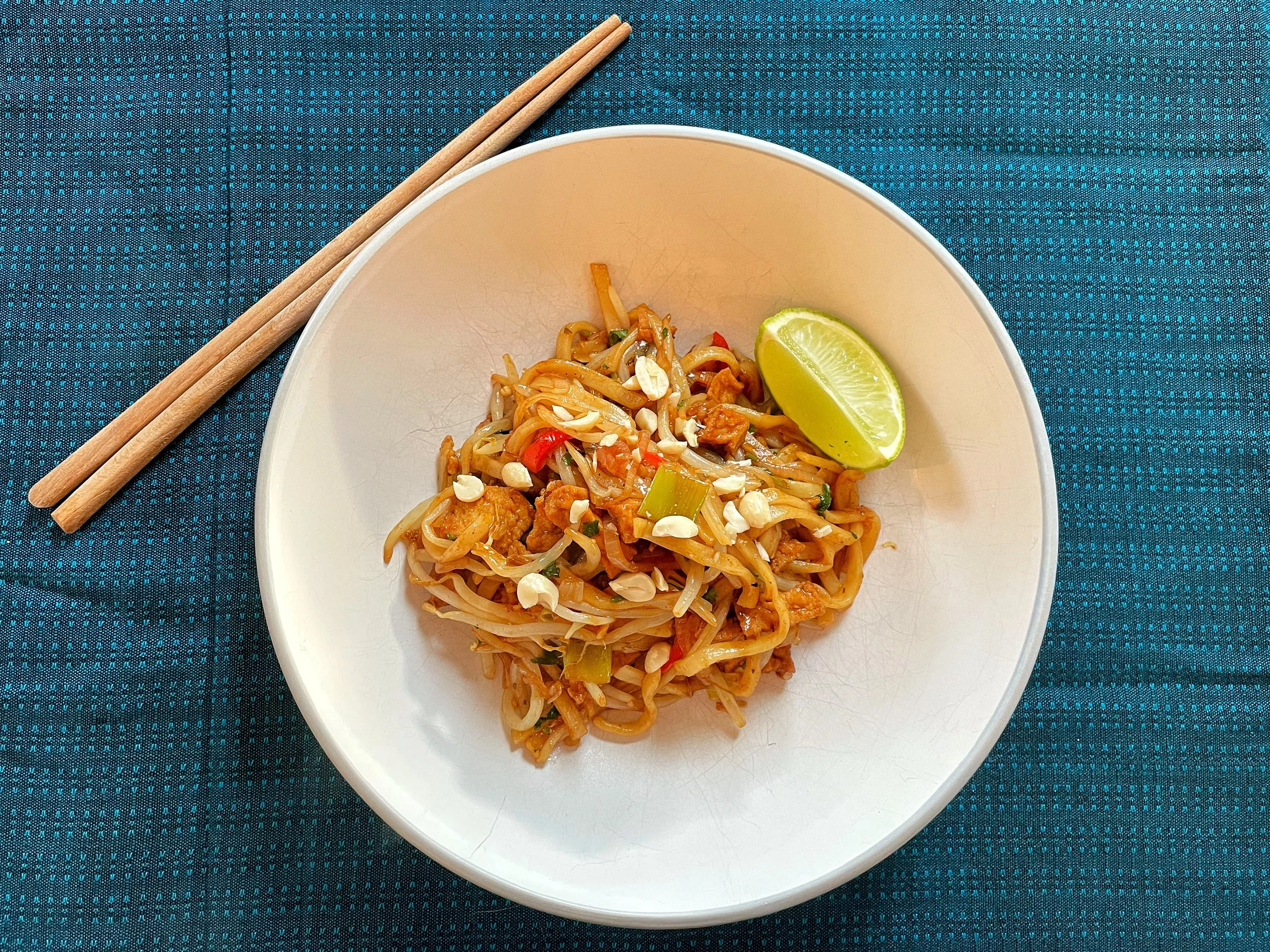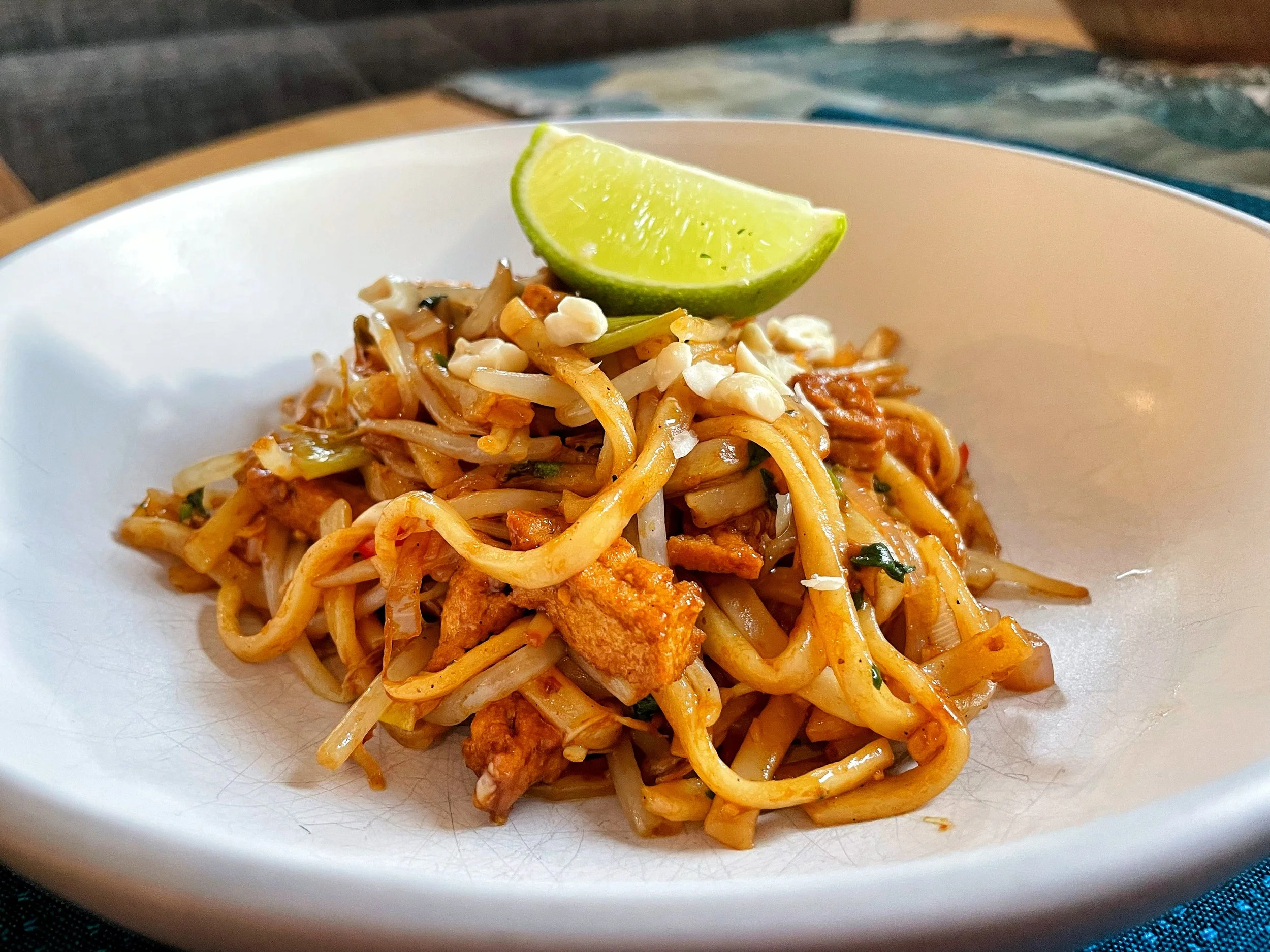Tofu Pad Thai
When I was at high school I was lucky enough to go on a school trip to Thailand as part of a school exchange programme. The competition was fierce, and to apply for a place involved writing essays and taking part in interviews to prove that you were a worthy “school ambassador”. Along with five others, I was chosen to represent the school and got to spend ten days travelling around Thailand, first in the north of the country seeing the sights and soaking up some culture, followed by a stint at our partner school in the central region. Before this trip the furthest I’d travelled was the south of France, and my first flight (to the aforementioned destination) was only a year previous, so it was quite a feat for thirteen year old me at the time! It was an amazing experience learning about their culture and getting to know some of the students at our partner school, but one of the best things about the trip has to have been the food.
If you’ve yet to try Thai food, please go and source some for yourself as quickly as you can (or make this recipe of course!). As a cuisine it is known for its aromatic flavours with its combination of hot, sour, sweet and salty. While Thai food can be ferociously spicy (I used to live near a Thai takeaway that allowed you to pick your spice levels from 1-5; I like my food fairly spicy and I don’t think I ever ventured higher than a 2), there is such a variety of dishes that there really is something for everyone, from the mild Massaman curries and noodle dishes to the more daring curries and salads. Being vegetarian, you do have to be wary of the ubiquitous fish sauce (nam pla) that can make its way into most dishes, so do check before you order whether the dish contains it. Cooking Thai food yourself, however, means that recipes can be adapted easily to your dietary requirements.
Pad Thai translates to “Thai stir-fry” which is a very accurate description of what’s going on here. This recipe is an adaptation of Ken Hom’s vegetable pad Thai recipe on the BBC Food website, with a few adjustments. Our aromatics (spring onions, shallots, chilli and garlic) are fried quickly in a wok, followed by the sweet and savoury sauce, noodles and beansprouts, before being dished up with a sprinkling of coriander and peanuts and a squeeze of lime. Most of the sauce ingredients should be available in large supermarkets, but you may need to look further afield for a vegetarian oyster sauce (Sous Chef sell it here for a reasonable price, or there are recipes online to make your own). I add tofu to my Pad Thai, for protein and flavour, dial back the chilli for the more delicate palette, and use quick cook ribbon noodles to save on time and washing up (this dish can be made in a single wok). Because it’s so quick to cook - around 30 minutes from prep to plate - it’s an ideal meal for a weeknight, and the leftovers can be stored in an air-tight container in the fridge and heated up in the microwave the next day with no issue. This vegan meal is a great introduction to Thai cuisine - let me know what you think of it in the comments!
Tofu Pad Thai
Serves: 4 | Total time: 30 mins | Source: BBC Food/vicki cooks veggie
Ingredients
2 banana/echalion shallots, halved lengthways then sliced widthways into crescents
4 spring onions (or the whole bunch if they’ll go to waste otherwise), sliced into 1cm pieces
1 red chilli, sliced (more if you like it spicy)
3 cloves garlic, crushed and chopped
4 tbsp soy sauce (ideally light soy sauce but dark works too)
1 tbsp Shaoxing rice wine
1 tbsp lime juice (or about half a lime)
2 tbsp vegetarian oyster sauce
1 tbsp granulated sugar
Salt and pepper to taste
2 tbsp vegetable oil
160g (6oz) marinated tofu pieces (I like the teriyaki flavoured ones)
300g (11oz) quick cook ribbon noodles (if you want to use dried noodles, you’ll need to soak them as per the package instructions first)
300g (11oz) beansprouts
15g (½oz) coriander (stalks and leaves), chopped
Handful of peanuts, chopped
Method
Prepare the shallots, spring onions, red chilli and garlic and set them to one side.
To make the sauce, take a small bowl and add the soy sauce, Shaoxing rice wine, lime juice, oyster sauce, sugar and some salt and pepper. Mix well and set aside.
Place a wok on a high heat and add the oil. When the oil is hot, add your vegetables and stir-fry for one minute, stirring constantly.
Add the sauce, noodles and tofu to the pan and cook for 2 minutes, mixing well to help the sauce thicken up a bit.
Add the beansprouts to the pan and continue to cook for 4 minutes. During this time, chop up your coriander and peanuts.
Once the beansprouts have wilted, add in the coriander, give it a final stir, then serve with the chopped peanuts sprinkled on top and a lime wedge if you have one handy.


